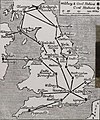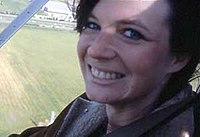Portal:Aviation
| Main page | Categories & Main topics |
|
Tasks and Projects |
The Aviation Portal

Aviation includes the activities surrounding mechanical flight and the aircraft industry. Aircraft includes fixed-wing and rotary-wing types, morphable wings, wing-less lifting bodies, as well as lighter-than-air aircraft such as hot air balloons and airships.
Aviation began in the 18th century with the development of the hot air balloon, an apparatus capable of atmospheric displacement through buoyancy. Clément Ader built the "Ader Éole" in France and made an uncontrolled, powered hop in 1890. This is the first powered aircraft, although it did not achieve controlled flight. Some of the most significant advancements in aviation technology came with the controlled gliding flying of Otto Lilienthal in 1896; then a large step in significance came with the construction of the first powered airplane by the Wright brothers in the early 1900s. Since that time, aviation has been technologically revolutionized by the introduction of the jet which permitted a major form of transport throughout the world. (Full article...)
Selected article
The plane crashed in a field just outside Shanksville, Pennsylvania, about 150 miles (240 km) northwest of Washington, D.C., killing all 44 people aboard, including the hijackers. Many witnessed the impact from the ground and news agencies began reporting on the event within an hour. The plane fragmented upon impact, leaving a crater, and some debris was blown miles from the crash site. The remains of everyone on board the aircraft were later identified. Subsequent analysis of the flight recorders revealed how the actions taken by the passengers prevented the aircraft from reaching either the White House or United States Capitol. A permanent memorial is planned for construction on the crash site. The chosen design has been the source of criticism and is scheduled to be dedicated in 2011. (Full article...)
Selected image
Did you know
...the study of airmail is known as aerophilately? ...that Frenchman Jean-Marie Le Bris accomplished the world's first powered flight in 1856, with a glider that was pulled behind a running horse? ...that the Lockheed NF-104A (pictured), equipped with a reaction control system as well as a rocket engine to supplement a jet engine, was a low-cost training vehicle for American astronauts in the 1960s?
General images -
In the news
- May 29: Austrian Airlines cancels Moscow-bound flight after Russia refuses a reroute outside Belarusian airspace
- August 8: Passenger flight crashes upon landing at Calicut airport in India
- June 4: Power firm helicopter strikes cables, crashes near Fairfield, California
- January 29: Former basketball player Kobe Bryant dies in helicopter crash, aged 41
- January 13: Iran admits downing Ukrainian jet, cites 'human error'
- January 10: Fire erupts in parking structure at Sola Airport, Norway
- October 27: US announces restrictions on flying to Cuba
- October 3: World War II era plane crashes in Connecticut, US, killing at least seven
- September 10: Nevada prop plane crash near Las Vegas leaves two dead, three injured
- August 6: French inventor Franky Zapata successfully crosses English Channel on jet-powered hoverboard
Related portals
Associated Wikimedia
The following Wikimedia Foundation sister projects provide more on this subject:
-
Commons
Free media repository -
Wikibooks
Free textbooks and manuals -
Wikidata
Free knowledge base -
Wikinews
Free-content news -
Wikiquote
Collection of quotations -
Wikisource
Free-content library -
Wikiversity
Free learning tools -
Wikivoyage
Free travel guide -
Wiktionary
Dictionary and thesaurus
Selected biography
Despite her surname, Jeana Yeager is not related to Chuck Yeager, the first man to break the sound barrier in level flight.
Selected Aircraft

NASA's Space Shuttle, officially called the Space Transportation System (STS), was the spacecraft which was used by the United States government for its human spaceflight missions. At launch, it consisted of a rust-colored external tank (ET), two white, slender Solid Rocket Boosters (SRBs), and the orbiter, a winged spaceplane which was the space shuttle in the narrow sense.
The orbiter carried astronauts and payload such as satellites or space station parts into low Earth orbit, into the Earth's upper atmosphere or thermosphere. Usually, five to seven crew members rode in the orbiter. The payload capacity was 22,700 kg (50,000 lb). When the orbiter's mission was complete, it fired its Orbital Maneuvering System (OMS) thrusters to drop out of orbit and re-enter the lower atmosphere. During the descent and landing, the shuttle orbiter acted as a glider, and made a completely unpowered ("dead stick") landing.
- Span: 78.06 ft (23.79 m)
- Length: 122.17 ft (37.24 m)
- Height: 58.58 ft (17.25 m)
- Engines: 3 Rocketdyne Block 2 A SSMEs
- Cruising Speed: 25,404 ft/s (7,743 m/s, 27,875 km/h, 17,321 mi/h)
- First Flight: August 12, 1977 (glider), April 12, 1981 (powered).
- Operational Altitude: 100 to 520 nmi (185 to 1,000 km)
- Number built: 6 (+2 mockups)
Today in Aviation
- 2012 – EasySky Flight 735, While attempting to land at San Pedro Sula Airport, the aircraft veered off the runway and ran into a ditch about 130 feet off the runway before coming to a stop. There were no serious injuries among the crew of 2 and 17 passengers. The captain received minor injuries. The crew reported a problem with the brakes during roll out just before the aircraft veered off the runway.[1]
- 2012 – The Kachin Independence Army again claims to be under attack by Myanmar Air Force aircraft.[2]
- 2012 – Aleppo International Airport is closed due to fighting between Syrian government and rebel forces around the base of the Syrian Army force protecting the airport.[3]
- 1999 – Fear of the Y2 K computer bug and possible in-flight consequences for those planes flying during the night of December 31, 1999 and the early morning of January 1, 2000, spreads around the airline industry.
- 1989 – First flight of the Sukhoi Su-30
- 1985 – Singer-songwriter and actor Ricky Nelson and six others die in the crash of a Douglas DC-3 near DeKalb, Texas.
- 1972 – Baseball player Roberto Clemente dies when his chartered DC-7 crashes into the ocean off the coast of Isla Verde, Puerto Rico, immediately after takeoff. Clemente was attempting to deliver relief supplies to Managua, Nicaragua, after a massive earthquake on December 23.
- 1970 – Jeanne Holm becomes the USAF's first female General
- 1968 – First flight of the Tupolev Tu-144
- 1968 – MacRobertson Miller Airlines Flight 1750, a Vickers Viscount, crashes in Australia, killing all 26 people on board.
- 1967 – The Royal Air Force's V-bomber force begins to be dismantled, pending the deployment of the Polaris missile aboard Royal Navy submarines to act as Britain's nuclear deterrent.
- 1967 – NASA begins initial talks to develop guidelines for a re-usable space plane.
- 1958 – First flight of the Boeing C-137 Stratoliner
- 1956 – A United States Air Force Lockheed C-121C, 54-165, crashed on approach to Dhahran, Saudi Arabia while flying UN troops into the Suez Canal zone. It was also carrying Hungarian refugees back to Charleston AFB, South Carolina. 12 of 38 onboard killed.[citation needed]
- 1951 – The year-end tally showed that for the first time, total passenger flying miles exceeded that of railroad miles at 10.6 million.
- 1944 – Entered Service: Grumman F8F Bearcat with the United States Navy
- 1944 – University Air Training Squadrons were disbanded.
- 1943 – Japanese Rabaul-based aircraft raid U. S. forces off Arawe, losing four aircraft.
- 1943 – Since mid-December, when they began staging through Tarawa Atoll, U. S. Army Air Forces B-24 Liberators have dropped 601 tons (545,227 kg) of bombs on the Marshall Islands.
- 1943 – Kawanishi N1K2-J Shiden Kai (“Violet Lightning Modified”), Allied reporting name “George”
- 1942 – (Overnight) Guided by an Oboe-equipped Mosquito, eight Pathfinder Force Avro Lancasters bomb on sky markers suspended by parachute for the first time in a raid on Düsseldorf. Bomber Command previously had employed only ground markers, and the new capability allows British bombers to bomb through ten-tenths cloud cover.
- 1942 – During 1942, the U. S. Army Air Forces' Eleventh Air Force has destroyed at least 50 Japanese aircraft in the Aleutian Islands campaign in exchange for the loss of 12 aircraft in combat and almost 80 to other causes. Japanese non-combat aircraft losses in the Aleutian Islands have been equally high. Since October 1, Eleventh Air Force aircraft have dropped 500,000 pounds (230,000 kg) of bombs on Japanese bases in the Aleutians.
- 1940 – A Vickers Wellington IA bomber, N2980, R for Robert, of No. 20 OTU, out of RAF Lossiemouth, suffers starboard engine failure at 8,000 feet in a snow storm whilst on a training flight over Great Glen, Scotland. Pilot, Squadron Leader Marlwood-Elton orders crew of six trainee navigators and the tail gunner to bail-out, all escaping safely save the gunner whose chute fails to open. Marlwood-Elton and P/O Slatter (also reported as Slater) then notice a body of water and they successfully ditch in the northern basin of Loch Ness near the A82 road, both escaping before the airframe sinks. Discovered by side-scan sonar in 1976, the rare Wellington is raised on 21 September 1985, and restored at Weybridge where she was built. Now on display at the Brooklands Museum, it is one of only two known intact Wellingtons.
- 1922 – The first German aircraft flies over Britain since the end of World War I, a Deutsche Luft-Reederei Dornier Komet
- 1908 – Wilbur Wright wins a prize of FF 20,000 from Michelin for the longest flight of the year – 124 kilometres (77 mi) from Camp d'Auvours.
References
- Shortcuts to this page: Portal:Airplanes • P:AVIA






















































